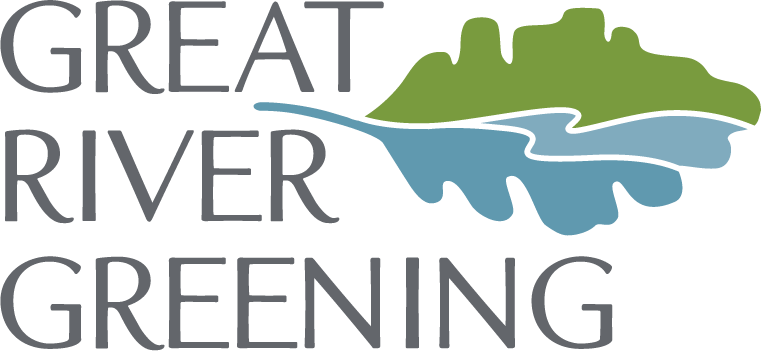Stewardship Spotlight: Carmen Gavin Vanegas — Bridging Education, Nature, and Cultural Stewardship
8/22/2024
Located in the heart of Minneapolis, South High School’s All Nations Program is a shining example of a vibrant learning community where traditional Indigenous knowledge is woven into the academic curriculum. Today, we are thrilled to shine the spotlight on Carmen Gavin Vanegas, an exceptional Great River Greening partner, volunteer and dedicated educator with the All Nations Program – whose work exemplifies the powerful intersection of education, cultural heritage, and environmental stewardship.
A Hub of Cultural and Academic Excellence
Carmen teaches physics, earth and space science, chemistry, and biology at South High School, a school with a high American Indian student population. Her teaching philosophy is grounded in Culturally and Linguistically Responsive Teaching (CLRT), an approach that celebrates and incorporates the diverse strengths of Indigenous students and students of color. This method makes learning more relevant and engaging for all students.
For Carmen, the All Nations Program was an opportunity to bridge educational excellence with cultural and environmental stewardship. Established in 1989, the All Nations Program offers Indigenous students an opportunity to study Dakota and Ojibwe languages and engage in experiential learning opportunities that connect them deeply with their cultural heritage while receiving a comprehensive education. With 132 students enrolled this year, the program serves as a citywide initiative, welcoming students from across the Minneapolis school district.
Hands-On Learning and Cultural Engagement
Carmen’s collaboration with Great River Greening began over a decade ago, driven by her students’ desire to restore native plants at Oȟéyawahe, a traditional sacred site to the Dakota people. It looks over the mouth of the Minnesota River or Bdote Mnisota, which many Dakota people consider the center of the earth. While the landscape at Oȟéyawahe has been altered over the past 200 years, its sacred significance remains and continues to be an important place for the Dakota community to return to for gatherings and ceremonies.
Twice a year, through Great River Greening’s Future Stewards Program, students visit the site and participate in hands-on restoration projects:
Buckthorn Removal: Removing invasive buckthorn to restore native plant communities and improve habitat quality.
Native Seed Planting: Planting seeds of native species to support ecological balance and biodiversity.
Seed Collection: Collecting seeds from native plants to ensure genetic diversity and aid in future restoration projects.
Students also engage in cultural activities that highlight the site’s historical significance. For example, students make their own lacrosse sticks at school and create and play lacrosse on-site, continuing a tradition practiced by generations before them.
“It is powerful for students to feel this continuity, showing that Indigenous people are still here and connected to their ancestors’ heritage.”
The partnership has also led to native plant gardens on the South school campus, featuring species of cultural importance. These gardens enhance the local environment and serve as living classrooms for students to learn about and engage with their heritage.
“As Carmen reflects, “we have been lucky to expand this partnership, which has allowed students to build a long-term connection to the restoration site, contribute to conservation at other sacred sites, and develop native plant gardens with culturally important species on our school campus.”
The Restorative Power of Nature
For Indigenous youth, connecting with culturally significant plants is restorative. Dakota and Ojibwe teachers, Shiela and Bezh, along with Gabby Menomen from Wakan Tipi, believe sharing their plant knowledge enriches students’ lives by understanding their importance, allowing them to integrate healthy foods and medicines into their lives.
Creating Future Stewards
Carmen’s lifelong passion for the outdoors – through camping, fishing, canoeing and foraging, led her to study plant biology and pathology and eventually become a teacher. Carmen’s dedication and passion is fostering a new generation of environmental stewards, guided by knowledge, tradition, and an unwavering commitment to the natural world.
With Great River Greening’s support, Carmen and her students are making meaningful strides in conservation and cultural preservation, ensuring that their connections to the land—and to each other—grow stronger every day.
Thank you, Carmen, for fostering a new generation of stewards who bridge education, nature, and cultural heritage.
Partner with us. Support Great River Greening. Volunteer.
Thank you to our partners and funders:
Minnesota Environment and Natural Resources Trust Fund (ENRTF) as recommended by the Legislative-Citizen Commission on Minnesota Resources (LCCMR)
Grissinger Family Foundation
Shred Right/Mason Family Foundation
Opus Foundation
Photo credits: May 2022: South High School students along with Carmen and Great River Greening staff begin work for the All Nations garden prep day (Julie Baumeister), May 2022: South High School students, Carmen, and Great River Greening staff on All Nations garden prep day. May of 2022 (Julie Baumeister), South High School students and Greening River Greening staff at the 2023 All Nations garden prep day (Brennan Blue).



